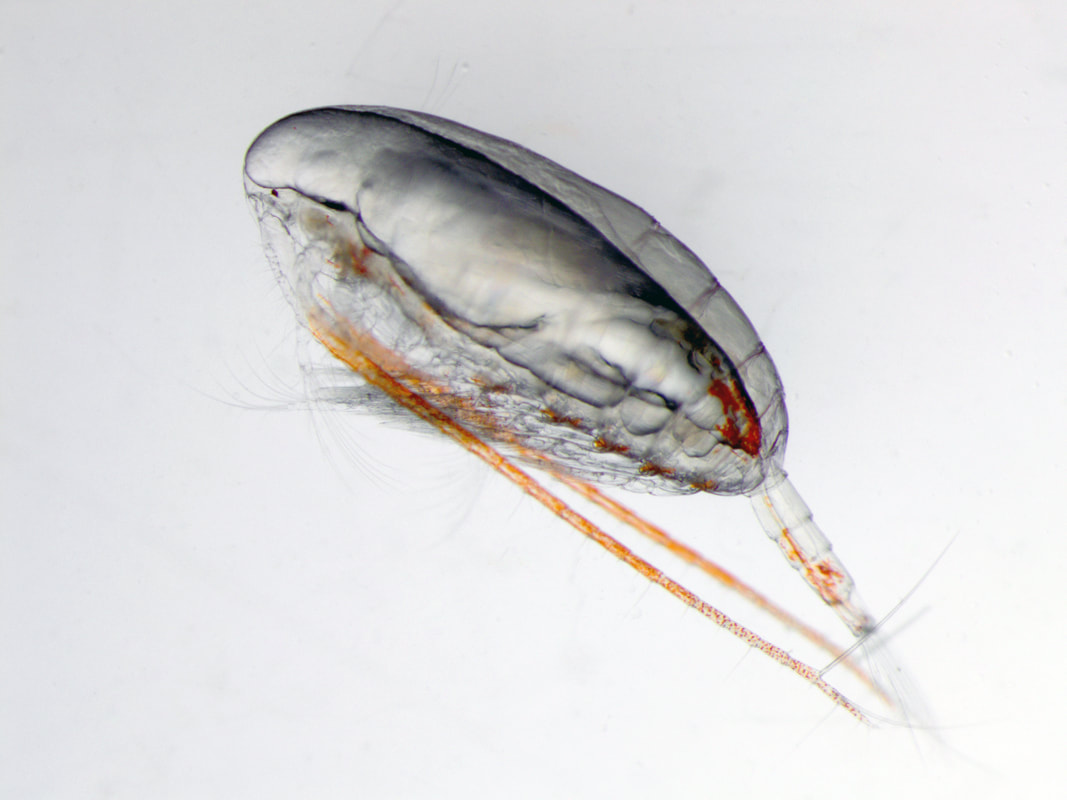"When colour matters –key Arctic zooplakton species as a source of carotenoids for seabirds during breeding period" (ORANGE)
- National Science Centre Poland (2021/41/B/NZ8/03830)
|
The aim of the ORANGE project is to investigate the variability of carotenoids in the key Arctic zooplankton species (Calanus copepods) and its impact on diet quality and condition of their main avian predators – planktivorous seabirds (little auks) during their breeding season. The project involves a multi-level study of the variability of carotenoids from protists through copepods to birds in various hydrographic regimes (Arctic, Atlantic and Frontal) in places where largest colonies of little auks are located – Svalbard Archipelago, Bear Island and Greenland. Due to the differences in environmental conditions, the varying exposure to Atlantification and the slightly different diet of birds in these areas, we hypothesize that carotenoids content will differ at each level in the pathway from protists through Calanus copepods to little auks. We assume these differences to be differently pronounced in various hydrographic regimes and between research areas with an expected higher values in locations affected by cold water masses and in the frontal zone. As both Calanus species (C. glacialis and C. finmarchicus), due to their ecological plasticity, show different feeding, lipid accumulation and reproductive strategies whether they occur in their optimal conditions, we assume that the carotenoid content will be a species-specific trait and will vary depending on the prevailing environmental conditions. We expect that these differences will have a direct impact on the carotenoid content in the birds' blood and consequently their condition and survival, especially that Calanus copepods may act as the only source of carotenoids for these highly selective predators.
|
"First attempt of genetic identification of Calanus copepods in the little auks' diet"
- National Science Centre Poland (2020/04/X/NZ8/00574)
|
The main goal of the project is to accurately determine the contribution of two species of copepods of the genus Calanus (C. glacialis and C. finmarchicus) in the diet of little auks, in relation to their availability in the feeding grounds of these birds under various environmental conditions. Both species, morphologically very similar to each other, until now were mainly identified by differences in body length. Recent studies have confirmed however, that their size ranges largely overlap, leading to their erroneous identification. While molecular methods began to be used for correct identification of Calanus in seawater samples, this verification has not been carried out so far in little little auks' food samples. The project will be the first such attempt. A fair comparison of the real share of both species in the diet with their availability in foraging grounds seems to be crucial not only to understand the scope of plasticity of little auks in relation to the availability of food in times of climate change and Atlantification, but it will also be an important step towards a better understanding of the processes taking place on the border of the marine and land environment in the gradually warming Arctic.
|
"Coast Carb - Coastal ecosystem carbon balance in times of rapid glacier melt"
- European Commission (H2020-MCSA-RISE 872690)
|
With over 100 researchers from 18 institutions from 9 countries from Europe, South America, US and Canada project aims to build up a multidisciplinary information system on carbon balance for South Patagonia and Western Antarctic. This will be done by gathering and analysing recent coastal ecosystem data sets from all the participants and their research stations (AR-DE Carlini-Dallmann, US Palmer, UK Rothera, PL Arctowski), creating and open access data portal with dynamic ecosystem models of subAntarctic fjordic and estuarine environments. All of this is for a better understanding of this rapidly changing, due to global warming, fragile and globally important area.
|
"Separation of two sibling Calanus species in little auks’ diet using molecular techniques"
- The Iwanowska Programme, Polish National Agency for Academic Exchange (PPN/IWA/2018/1/00080/U/0001)
|
The main objective of the project is to reexamine the contribution of two main diet components of the little auk nesting on Spitsbergen - Calanus glacialis and Calanus finmarchicus using molecular methods. The idea of the project was inspired by wildly described recent misidentification of two sibling Calanus spp. in Arctic zooplankton (Choquet et al. 2018). Both species, although morphologically very similar, represents different life history strategies and distribution ranges, in consequence also different respond to the ongoing climate change, so their proper identification is crucial in order to understand the large-scale changes which taking place currently in the Arctic environment. Genetic methods have not been used to identify these individuals in the little auks’ diet, which so far have been thought to be focused mainly on C. glacialis due to assumed larger body size and higher lipid content. However in the light of recent studies indicated broader size ranges of Calanus spp. than previously realized and that lipid content is not a species characteristic, but is related to body size of their prey, current approach requires serious reevaluation. Thus, the research carried out as part of the project will contribute to filling the evident gaps in knowledge of these key species in the Arctic ecosystem and will contribute to predicting their responses to climate change in the future.
|




